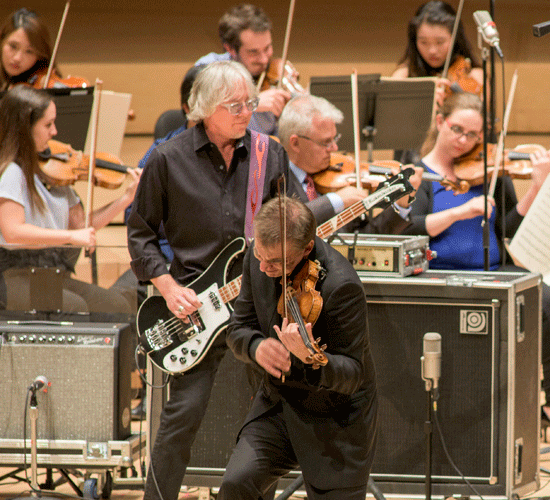
R.E.M.’s Mike Mills returns with a foray into classical music
Robert McDuffie is a star. The violinist has been the featured soloist with major symphonies around the world. He plays a $3.5 million violin made in 1735. He has enough clout to commission work from Philip Glass. As a kid in Macon, Ga., he sang in church choirs with his high-school pal Mike Mills, who went on to a different kind of stardom as bassist/pianist/vocalist/songwriter for R.E.M.
The two kept in touch, and not long ago, when McDuffie was looking to commission new music, he floated the idea that Mills write a classical piece. Mills’ first reaction?
“‘This guy’s crazy,’” says Mills from his home in Athens, Ga. “Actually, I found it very intriguing. I knew right away it would be a pretty big challenge, but I thought it was something worth considering.” The result: Mills’ Concerto For Violin, Rock Band And String Orchestra. Mills’ father was a dramatic tenor who sang opera, and the family listened to classical music at home. Mills had a bit role as a street urchin in a performance of Aida when he was nine. His adult relationship with classical music has been less immersive, although he has followed McDuffie’s career and goes to the Atlanta Symphony occasionally.
Mills approached the project as a rock songwriter rather than as a classical composer. “I tried to view it as writing five or six songs, like I would have done for R.E.M., except I had to come up with the main melodies, which would normally have been Michael (Stipe)’s purview,” he says. “To me, melody is always the most important part of a song, and I knew since there would be no lyrics involved here that melody was going to be absolutely essential. So I just worked really hard to come up with the best melodies I could.”
The concerto is full of dramatic moments. It begins with a bass melody, played by Mills, that McDuffie quickly picks up and turns into a wild violin solo. The prominence of the drums, played by Patrick Ferguson, provide a rock ’n’ roll bedrock, as do electric guitars (from John Neff and William Tonks), but McDuffie’s lightning violin lines and the grandeur of the string orchestra (played by students from the Robert McDuffie Center for Strings at Mercer University) identify more as classical.
Writing for a lead violin was another challenge. Mills composed the melodies on a variety of instruments, but he had to imagine how they would translate to the instrument. Arranger David Mallamud was crucial in this role. “There were a lot places a violin could go that I was not familiar,” says Mills. “A lot of bowing techniques that can make a difference, a lot of glissandi and other things.”
R.E.M. fans will immediately recognize one segment, when Mills starts playing the familiar circular piano figure of “Nightswimming.” It also incorporates the oboe part that Led Zeppelin’s John Paul Jones arranged for the original R.E.M. recording. McDuffie and Mills had performed “Nightswimming” a few times before as a standalone, and McDuffie suggested using it in the concerto. It’s one of the more somber moments in a piece that’s lively, wild and fun.
While some rock songwriters seem to turn to penning a classical opus as a bid for highbrow cred (here’s looking at you, Billy Joel and Paul McCartney), Mills isn’t too worried about pretentions. “Of course, that is something to be aware of,” he says. “Two things I’ll say about that. One, I’m not completely unfamiliar with classical music. I certainly grew up with it; it’s been around me all my life. Another thing, when you listen to the concerto, it’s fun. There’s nothing stodgy about it; it’s playful. To me, it’s to be enjoyed rather than respected.”
Mills and McDuffie were interested in bridging the distance between their respective worlds of rock and classical music, and Mills dismisses the notion of lines between lowbrow and highbrow in music in general. After all, the Minus 5, the Scott McCaughey-led band that includes Mills and former R.E.M. bandmate Peter Buck, recently released an album that commemorates the Monkees, who were sometimes unjustly derided as the Prefab Four.
“Let me hasten to say, one of the highlights of my musical career was playing guitar with Micky Dolenz on ‘Last Train To Clarksville’ and ‘I’m A Believer’ at a live show earlier this year,” says Mills. “Again, what we’re trying to go for here is just to break down those walls. To say that there are elements of any fields that we can enjoy no matter what your musical origin or musical taste is, especially if you don’t approach it from a snobby point of view. I think a lot of people write classical music thinking they only want to appeal to classical music fans. But this was done with the goal of appealing to as many types of music fans as possible.”
—Steve Klinge






